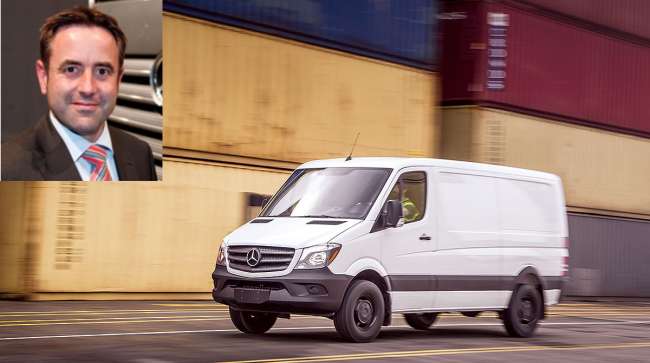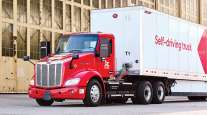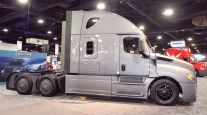Senior Reporter
Daimler Appoints Rainer Müller-Finkeldei to SVP Post

[Stay on top of transportation news: Get TTNews in your inbox.]
Daimler Trucks North America appointed Rainer Müller-Finkeldei senior vice president of engineering and technology.
He will assume responsibility for all DTNA product engineering activities, including design, testing, styling, analysis, compliance and planning functions.
He has served as director of mechatronics at Mercedes-Benz Trucks since 2010. Müller-Finkeldei joined Daimler’s research labs in 1995 while working on his Ph.D.
We're thrilled to announce the appointment of Dr. Rainer Müller-Finkeldei to the role of senior vice president of engineering and technology. Dr. Müller-Finkeldei brings a wealth of experience in vehicle development to this new role. — Daimler Trucks NA (@DaimlerTrucksNA) August 6, 2020
Since joining Daimler, he had roles of increasing responsibility across business units and engineering functions, including Daimler Trucks product creation group, electronics development at Daimler vans, and the company’s research and technology department.
“I have been working on artificial intelligence for the control of vehicles, predominantly in the powertrain, which today sounds like a pretty modern topic and something many people are working in. But I can tell you when I started this in 1995, nobody knew what artificial intelligence is. Nobody had ever heard of neural networks. And people were thinking we were simply doing crazy things,” Müller-Finkeldei said during an online press conference.
“I feel I have had a chance to be in it in the pilot phase and that helps as we work on those subjects today,” he added. “Over the last 10 years, the electronic, mechatronics portion in our trucks has become a pretty dominant factor.”
Mechatronic systems such as braking or steering systems, automatic transmissions, chassis systems and engine management are characterized by the complex interaction of electronics and the mechanics they involve, according to the truck maker.
He also has worked on transformation in the way information is presented in the truck cab through systems relying on the human-machine interface — such as touch displays and configurable displays — “getting the right information to the driver at the right time during the journey.”

Connectivity is changing trucking today and into the future, including how it could enable electric and self-driving trucks. Host Seth Clevenger talks with two experts from Penske Transportation Solutions, Bill Combs and Samantha Thompson. Hear a snippet, above, and get the full program by going to RoadSigns.TTNews.com.
He said he was excited DTNA has “taken the lead” with electric drive systems in its eCascadia and eM2 vehicles and considers EVs one of the key elements of the future of trucking.
He noted Daimler is already offering series production of e-buses for city transportation in Europe and through that gained insights into running electric vehicles in day-to-day operations.
So far its e-trucks are in limited volume with high-priced components, he said.
“The cost of the technology is still too high to compete on an economical basis with conventional vehicles with diesel. But we are working on what we call Generation 2 technologies, which will be a classical series-development component, and we are thinking ahead and looking into what new advancements do we see, for example batteries. And batteries will be the dominant cost factor for the vehicle,” said Müller-Finkeldei, who will also join DTNA’s operating committee as part of the move.
Meanwhile, within the decade, electric-drive trucks operating in a range of up to 200 miles will be able to compete economically with diesel engines — arriving on the roads as certain areas ban the use of combustion engines and society demands zero-emission transportation, he said.
He also looks forward to continuing to pioneer autonomous driving, which he said brings the potential for changing transportation globally.
“We are learning everyday with trucks out on the road how to make [SAE Level 4] happen,” he said, and hub-to-hub deliveries on known routes have a good chance of being the first where Level 4 autonomous driving is possible and “really makes sense.”
As for when that happens, it’s still a ways out with some “problems to conquer and solve. I am pretty confident we make this happen still in this decade,” he said. “Everybody is learning this is a highly complex task.”
Besides EVs and autonomous trucks, he said connectivity and data management is the other key area Daimler is working on. “And up to now, we have the possibility to invest and work in all three of them.”
At the same time, diesel still rules the roads, “and there is still some work to do in that domain to bring the benefits to our customers [of cleaner diesel] and also to the environment over quite some years to come.”

Achenbach
Closer at hand is a DTNA project called 43N that is developing the next Western Star vocational truck. He said it involved taking all “we know about trucking, taking all our technology, and also the clear expectation of understanding what our customers need in the vocational domain. [That] is exactly what we are working on.”
In his new post, he succeeds Wilfried Achenbach who will retire after serving 10 years in the position.
Achenbach leaves an enduring mark on the DTNA team having solidified an engineering culture defined by its values of teamwork, engineering excellence, fuel economy leadership and, above all, safety, according to the Portland, Ore.-based company. Under Achenbach’s stewardship, DTNA became the first commercial vehicle manufacturer in North America to introduce an award-winning SAE Level 2 advanced driver assistance system, Detroit Assurance.
Want more news? Listen to today's daily briefing:
Subscribe: Apple Podcasts | Spotify | Amazon Alexa | Google Assistant | More




